Green Technology and Sustainable Organic Food Farming in India
VerifiedAdded on 2023/06/10
|10
|2704
|94
Essay
AI Summary
This essay explores the application of green technology, specifically focusing on organic food farming and agriculture in India. It begins by defining green technology and outlining its four pillars: sustainability, source reduction, innovation, and viability. The essay then discusses the choice of organic food farming as a green technology, highlighting its benefits and challenges. It examines India's agricultural landscape, the government's initiatives, and the importance of technology transfer. The essay further delves into the role of international technology transfer, the impediments faced by developing countries, and the contributions of multinational corporations. It also emphasizes the significance of local innovation, traditional communities, and sustainable development goals. The essay concludes by emphasizing the symbiotic relationship between technology transfer and innovation, highlighting the economic and environmental benefits of green technology in the context of organic farming.
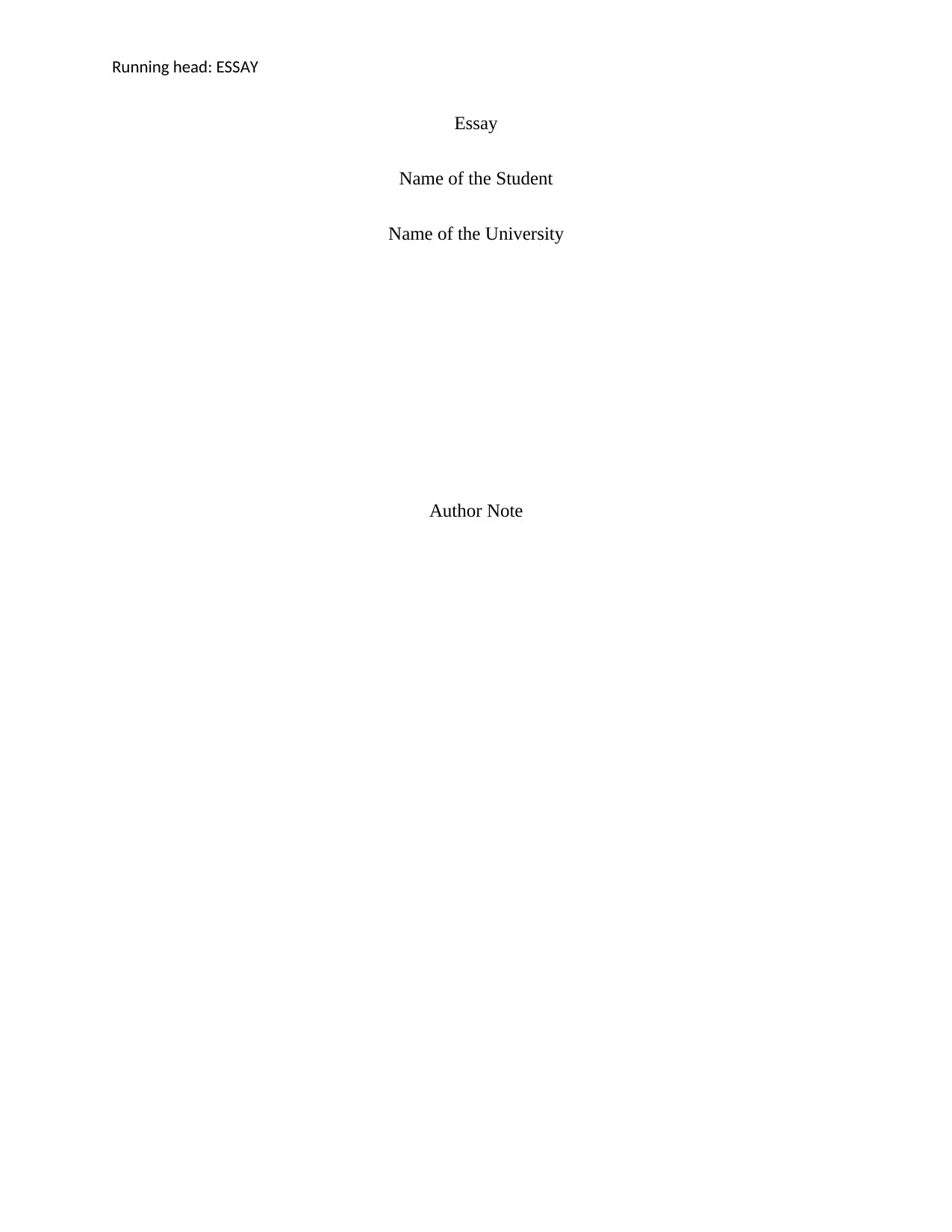
Running head: ESSAY
Essay
Name of the Student
Name of the University
Author Note
Essay
Name of the Student
Name of the University
Author Note
Paraphrase This Document
Need a fresh take? Get an instant paraphrase of this document with our AI Paraphraser
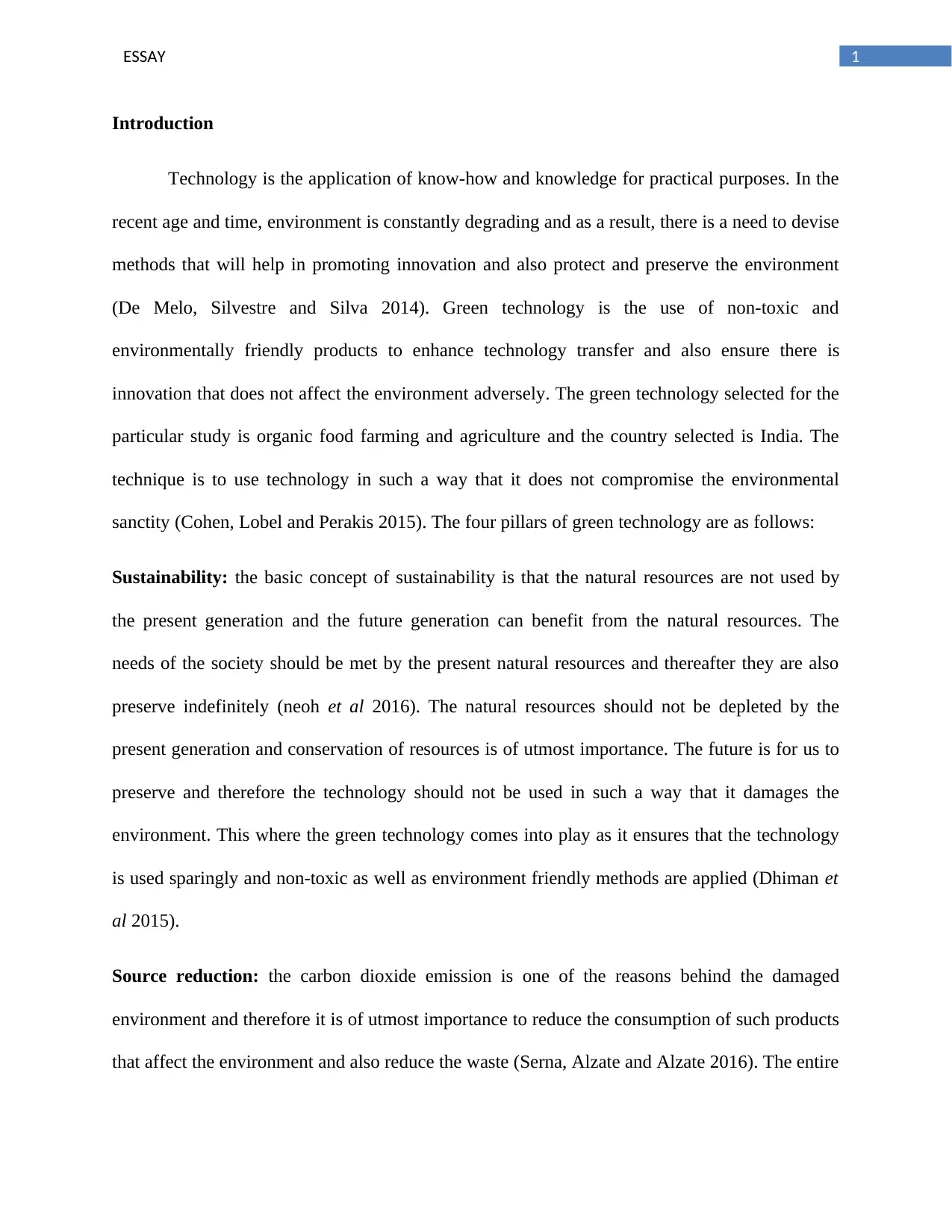
1ESSAY
Introduction
Technology is the application of know-how and knowledge for practical purposes. In the
recent age and time, environment is constantly degrading and as a result, there is a need to devise
methods that will help in promoting innovation and also protect and preserve the environment
(De Melo, Silvestre and Silva 2014). Green technology is the use of non-toxic and
environmentally friendly products to enhance technology transfer and also ensure there is
innovation that does not affect the environment adversely. The green technology selected for the
particular study is organic food farming and agriculture and the country selected is India. The
technique is to use technology in such a way that it does not compromise the environmental
sanctity (Cohen, Lobel and Perakis 2015). The four pillars of green technology are as follows:
Sustainability: the basic concept of sustainability is that the natural resources are not used by
the present generation and the future generation can benefit from the natural resources. The
needs of the society should be met by the present natural resources and thereafter they are also
preserve indefinitely (neoh et al 2016). The natural resources should not be depleted by the
present generation and conservation of resources is of utmost importance. The future is for us to
preserve and therefore the technology should not be used in such a way that it damages the
environment. This where the green technology comes into play as it ensures that the technology
is used sparingly and non-toxic as well as environment friendly methods are applied (Dhiman et
al 2015).
Source reduction: the carbon dioxide emission is one of the reasons behind the damaged
environment and therefore it is of utmost importance to reduce the consumption of such products
that affect the environment and also reduce the waste (Serna, Alzate and Alzate 2016). The entire
Introduction
Technology is the application of know-how and knowledge for practical purposes. In the
recent age and time, environment is constantly degrading and as a result, there is a need to devise
methods that will help in promoting innovation and also protect and preserve the environment
(De Melo, Silvestre and Silva 2014). Green technology is the use of non-toxic and
environmentally friendly products to enhance technology transfer and also ensure there is
innovation that does not affect the environment adversely. The green technology selected for the
particular study is organic food farming and agriculture and the country selected is India. The
technique is to use technology in such a way that it does not compromise the environmental
sanctity (Cohen, Lobel and Perakis 2015). The four pillars of green technology are as follows:
Sustainability: the basic concept of sustainability is that the natural resources are not used by
the present generation and the future generation can benefit from the natural resources. The
needs of the society should be met by the present natural resources and thereafter they are also
preserve indefinitely (neoh et al 2016). The natural resources should not be depleted by the
present generation and conservation of resources is of utmost importance. The future is for us to
preserve and therefore the technology should not be used in such a way that it damages the
environment. This where the green technology comes into play as it ensures that the technology
is used sparingly and non-toxic as well as environment friendly methods are applied (Dhiman et
al 2015).
Source reduction: the carbon dioxide emission is one of the reasons behind the damaged
environment and therefore it is of utmost importance to reduce the consumption of such products
that affect the environment and also reduce the waste (Serna, Alzate and Alzate 2016). The entire
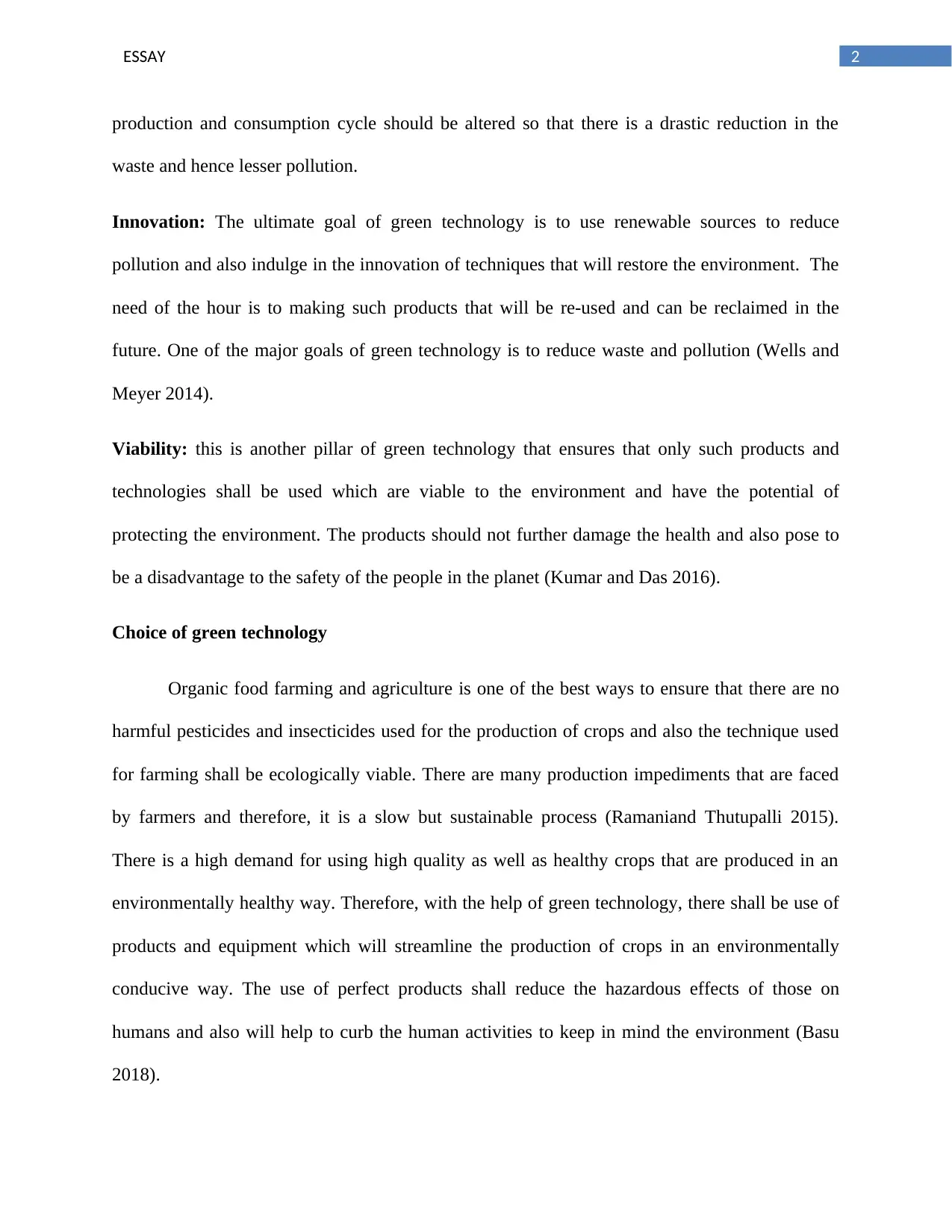
2ESSAY
production and consumption cycle should be altered so that there is a drastic reduction in the
waste and hence lesser pollution.
Innovation: The ultimate goal of green technology is to use renewable sources to reduce
pollution and also indulge in the innovation of techniques that will restore the environment. The
need of the hour is to making such products that will be re-used and can be reclaimed in the
future. One of the major goals of green technology is to reduce waste and pollution (Wells and
Meyer 2014).
Viability: this is another pillar of green technology that ensures that only such products and
technologies shall be used which are viable to the environment and have the potential of
protecting the environment. The products should not further damage the health and also pose to
be a disadvantage to the safety of the people in the planet (Kumar and Das 2016).
Choice of green technology
Organic food farming and agriculture is one of the best ways to ensure that there are no
harmful pesticides and insecticides used for the production of crops and also the technique used
for farming shall be ecologically viable. There are many production impediments that are faced
by farmers and therefore, it is a slow but sustainable process (Ramaniand Thutupalli 2015).
There is a high demand for using high quality as well as healthy crops that are produced in an
environmentally healthy way. Therefore, with the help of green technology, there shall be use of
products and equipment which will streamline the production of crops in an environmentally
conducive way. The use of perfect products shall reduce the hazardous effects of those on
humans and also will help to curb the human activities to keep in mind the environment (Basu
2018).
production and consumption cycle should be altered so that there is a drastic reduction in the
waste and hence lesser pollution.
Innovation: The ultimate goal of green technology is to use renewable sources to reduce
pollution and also indulge in the innovation of techniques that will restore the environment. The
need of the hour is to making such products that will be re-used and can be reclaimed in the
future. One of the major goals of green technology is to reduce waste and pollution (Wells and
Meyer 2014).
Viability: this is another pillar of green technology that ensures that only such products and
technologies shall be used which are viable to the environment and have the potential of
protecting the environment. The products should not further damage the health and also pose to
be a disadvantage to the safety of the people in the planet (Kumar and Das 2016).
Choice of green technology
Organic food farming and agriculture is one of the best ways to ensure that there are no
harmful pesticides and insecticides used for the production of crops and also the technique used
for farming shall be ecologically viable. There are many production impediments that are faced
by farmers and therefore, it is a slow but sustainable process (Ramaniand Thutupalli 2015).
There is a high demand for using high quality as well as healthy crops that are produced in an
environmentally healthy way. Therefore, with the help of green technology, there shall be use of
products and equipment which will streamline the production of crops in an environmentally
conducive way. The use of perfect products shall reduce the hazardous effects of those on
humans and also will help to curb the human activities to keep in mind the environment (Basu
2018).
⊘ This is a preview!⊘
Do you want full access?
Subscribe today to unlock all pages.

Trusted by 1+ million students worldwide
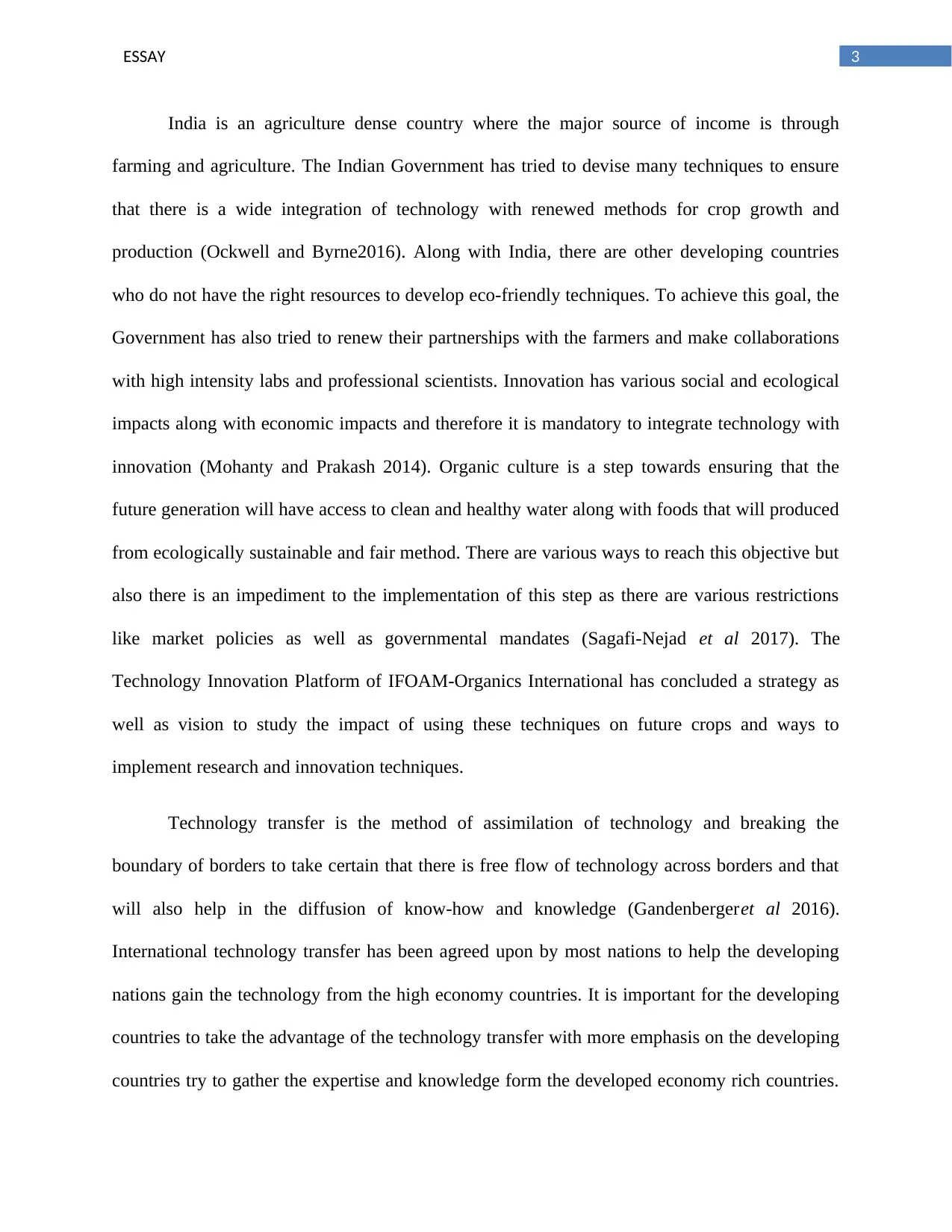
3ESSAY
India is an agriculture dense country where the major source of income is through
farming and agriculture. The Indian Government has tried to devise many techniques to ensure
that there is a wide integration of technology with renewed methods for crop growth and
production (Ockwell and Byrne2016). Along with India, there are other developing countries
who do not have the right resources to develop eco-friendly techniques. To achieve this goal, the
Government has also tried to renew their partnerships with the farmers and make collaborations
with high intensity labs and professional scientists. Innovation has various social and ecological
impacts along with economic impacts and therefore it is mandatory to integrate technology with
innovation (Mohanty and Prakash 2014). Organic culture is a step towards ensuring that the
future generation will have access to clean and healthy water along with foods that will produced
from ecologically sustainable and fair method. There are various ways to reach this objective but
also there is an impediment to the implementation of this step as there are various restrictions
like market policies as well as governmental mandates (Sagafi-Nejad et al 2017). The
Technology Innovation Platform of IFOAM-Organics International has concluded a strategy as
well as vision to study the impact of using these techniques on future crops and ways to
implement research and innovation techniques.
Technology transfer is the method of assimilation of technology and breaking the
boundary of borders to take certain that there is free flow of technology across borders and that
will also help in the diffusion of know-how and knowledge (Gandenbergeret al 2016).
International technology transfer has been agreed upon by most nations to help the developing
nations gain the technology from the high economy countries. It is important for the developing
countries to take the advantage of the technology transfer with more emphasis on the developing
countries try to gather the expertise and knowledge form the developed economy rich countries.
India is an agriculture dense country where the major source of income is through
farming and agriculture. The Indian Government has tried to devise many techniques to ensure
that there is a wide integration of technology with renewed methods for crop growth and
production (Ockwell and Byrne2016). Along with India, there are other developing countries
who do not have the right resources to develop eco-friendly techniques. To achieve this goal, the
Government has also tried to renew their partnerships with the farmers and make collaborations
with high intensity labs and professional scientists. Innovation has various social and ecological
impacts along with economic impacts and therefore it is mandatory to integrate technology with
innovation (Mohanty and Prakash 2014). Organic culture is a step towards ensuring that the
future generation will have access to clean and healthy water along with foods that will produced
from ecologically sustainable and fair method. There are various ways to reach this objective but
also there is an impediment to the implementation of this step as there are various restrictions
like market policies as well as governmental mandates (Sagafi-Nejad et al 2017). The
Technology Innovation Platform of IFOAM-Organics International has concluded a strategy as
well as vision to study the impact of using these techniques on future crops and ways to
implement research and innovation techniques.
Technology transfer is the method of assimilation of technology and breaking the
boundary of borders to take certain that there is free flow of technology across borders and that
will also help in the diffusion of know-how and knowledge (Gandenbergeret al 2016).
International technology transfer has been agreed upon by most nations to help the developing
nations gain the technology from the high economy countries. It is important for the developing
countries to take the advantage of the technology transfer with more emphasis on the developing
countries try to gather the expertise and knowledge form the developed economy rich countries.
Paraphrase This Document
Need a fresh take? Get an instant paraphrase of this document with our AI Paraphraser
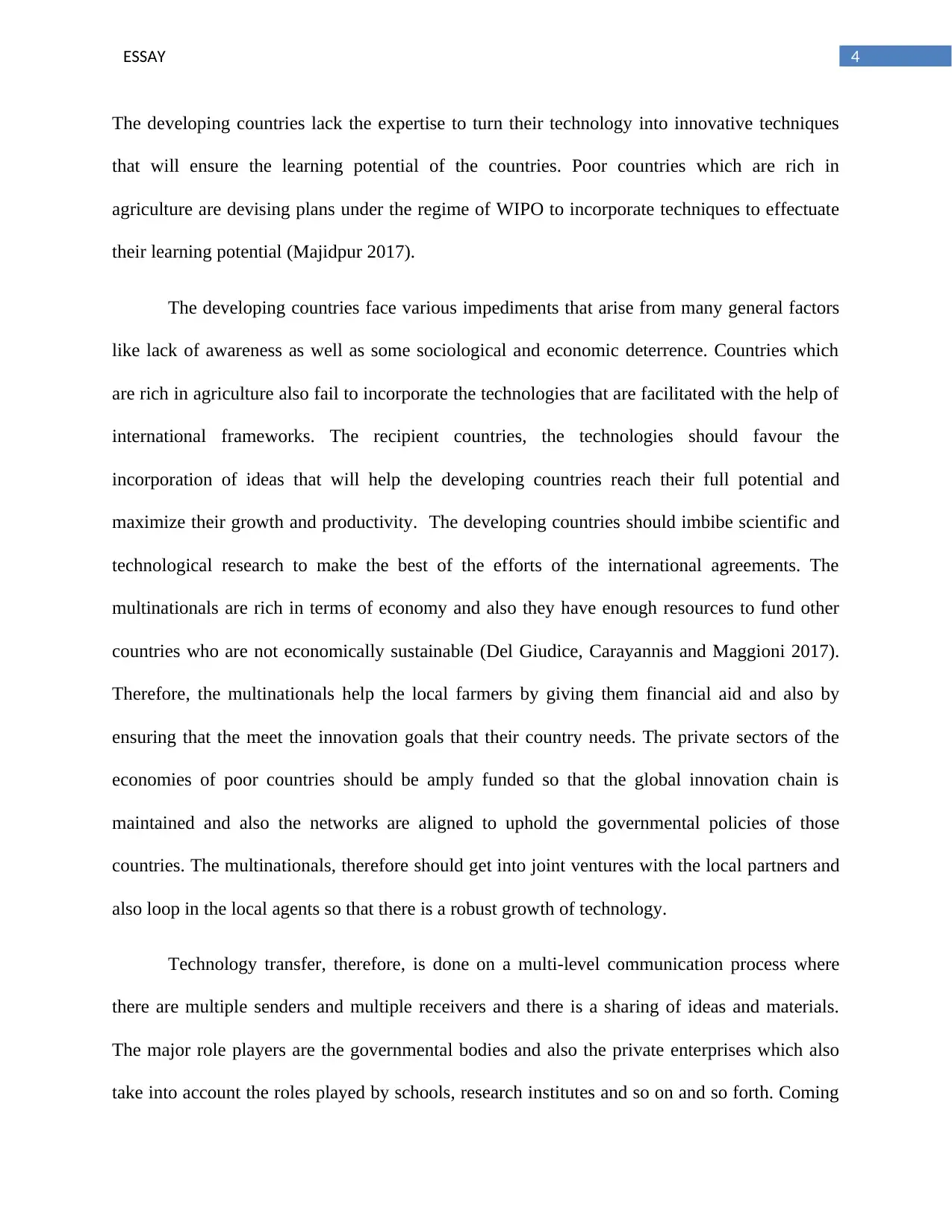
4ESSAY
The developing countries lack the expertise to turn their technology into innovative techniques
that will ensure the learning potential of the countries. Poor countries which are rich in
agriculture are devising plans under the regime of WIPO to incorporate techniques to effectuate
their learning potential (Majidpur 2017).
The developing countries face various impediments that arise from many general factors
like lack of awareness as well as some sociological and economic deterrence. Countries which
are rich in agriculture also fail to incorporate the technologies that are facilitated with the help of
international frameworks. The recipient countries, the technologies should favour the
incorporation of ideas that will help the developing countries reach their full potential and
maximize their growth and productivity. The developing countries should imbibe scientific and
technological research to make the best of the efforts of the international agreements. The
multinationals are rich in terms of economy and also they have enough resources to fund other
countries who are not economically sustainable (Del Giudice, Carayannis and Maggioni 2017).
Therefore, the multinationals help the local farmers by giving them financial aid and also by
ensuring that the meet the innovation goals that their country needs. The private sectors of the
economies of poor countries should be amply funded so that the global innovation chain is
maintained and also the networks are aligned to uphold the governmental policies of those
countries. The multinationals, therefore should get into joint ventures with the local partners and
also loop in the local agents so that there is a robust growth of technology.
Technology transfer, therefore, is done on a multi-level communication process where
there are multiple senders and multiple receivers and there is a sharing of ideas and materials.
The major role players are the governmental bodies and also the private enterprises which also
take into account the roles played by schools, research institutes and so on and so forth. Coming
The developing countries lack the expertise to turn their technology into innovative techniques
that will ensure the learning potential of the countries. Poor countries which are rich in
agriculture are devising plans under the regime of WIPO to incorporate techniques to effectuate
their learning potential (Majidpur 2017).
The developing countries face various impediments that arise from many general factors
like lack of awareness as well as some sociological and economic deterrence. Countries which
are rich in agriculture also fail to incorporate the technologies that are facilitated with the help of
international frameworks. The recipient countries, the technologies should favour the
incorporation of ideas that will help the developing countries reach their full potential and
maximize their growth and productivity. The developing countries should imbibe scientific and
technological research to make the best of the efforts of the international agreements. The
multinationals are rich in terms of economy and also they have enough resources to fund other
countries who are not economically sustainable (Del Giudice, Carayannis and Maggioni 2017).
Therefore, the multinationals help the local farmers by giving them financial aid and also by
ensuring that the meet the innovation goals that their country needs. The private sectors of the
economies of poor countries should be amply funded so that the global innovation chain is
maintained and also the networks are aligned to uphold the governmental policies of those
countries. The multinationals, therefore should get into joint ventures with the local partners and
also loop in the local agents so that there is a robust growth of technology.
Technology transfer, therefore, is done on a multi-level communication process where
there are multiple senders and multiple receivers and there is a sharing of ideas and materials.
The major role players are the governmental bodies and also the private enterprises which also
take into account the roles played by schools, research institutes and so on and so forth. Coming
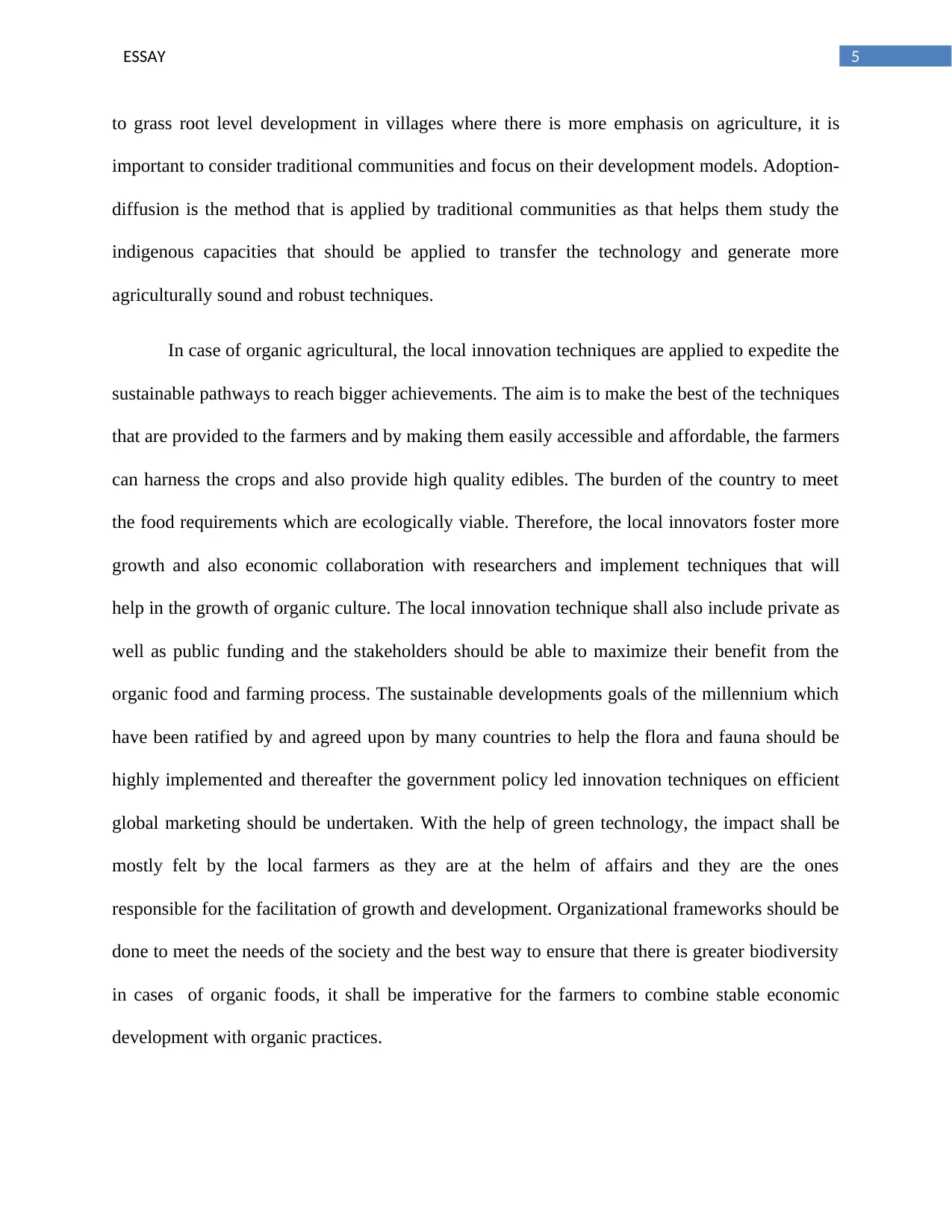
5ESSAY
to grass root level development in villages where there is more emphasis on agriculture, it is
important to consider traditional communities and focus on their development models. Adoption-
diffusion is the method that is applied by traditional communities as that helps them study the
indigenous capacities that should be applied to transfer the technology and generate more
agriculturally sound and robust techniques.
In case of organic agricultural, the local innovation techniques are applied to expedite the
sustainable pathways to reach bigger achievements. The aim is to make the best of the techniques
that are provided to the farmers and by making them easily accessible and affordable, the farmers
can harness the crops and also provide high quality edibles. The burden of the country to meet
the food requirements which are ecologically viable. Therefore, the local innovators foster more
growth and also economic collaboration with researchers and implement techniques that will
help in the growth of organic culture. The local innovation technique shall also include private as
well as public funding and the stakeholders should be able to maximize their benefit from the
organic food and farming process. The sustainable developments goals of the millennium which
have been ratified by and agreed upon by many countries to help the flora and fauna should be
highly implemented and thereafter the government policy led innovation techniques on efficient
global marketing should be undertaken. With the help of green technology, the impact shall be
mostly felt by the local farmers as they are at the helm of affairs and they are the ones
responsible for the facilitation of growth and development. Organizational frameworks should be
done to meet the needs of the society and the best way to ensure that there is greater biodiversity
in cases of organic foods, it shall be imperative for the farmers to combine stable economic
development with organic practices.
to grass root level development in villages where there is more emphasis on agriculture, it is
important to consider traditional communities and focus on their development models. Adoption-
diffusion is the method that is applied by traditional communities as that helps them study the
indigenous capacities that should be applied to transfer the technology and generate more
agriculturally sound and robust techniques.
In case of organic agricultural, the local innovation techniques are applied to expedite the
sustainable pathways to reach bigger achievements. The aim is to make the best of the techniques
that are provided to the farmers and by making them easily accessible and affordable, the farmers
can harness the crops and also provide high quality edibles. The burden of the country to meet
the food requirements which are ecologically viable. Therefore, the local innovators foster more
growth and also economic collaboration with researchers and implement techniques that will
help in the growth of organic culture. The local innovation technique shall also include private as
well as public funding and the stakeholders should be able to maximize their benefit from the
organic food and farming process. The sustainable developments goals of the millennium which
have been ratified by and agreed upon by many countries to help the flora and fauna should be
highly implemented and thereafter the government policy led innovation techniques on efficient
global marketing should be undertaken. With the help of green technology, the impact shall be
mostly felt by the local farmers as they are at the helm of affairs and they are the ones
responsible for the facilitation of growth and development. Organizational frameworks should be
done to meet the needs of the society and the best way to ensure that there is greater biodiversity
in cases of organic foods, it shall be imperative for the farmers to combine stable economic
development with organic practices.
⊘ This is a preview!⊘
Do you want full access?
Subscribe today to unlock all pages.

Trusted by 1+ million students worldwide
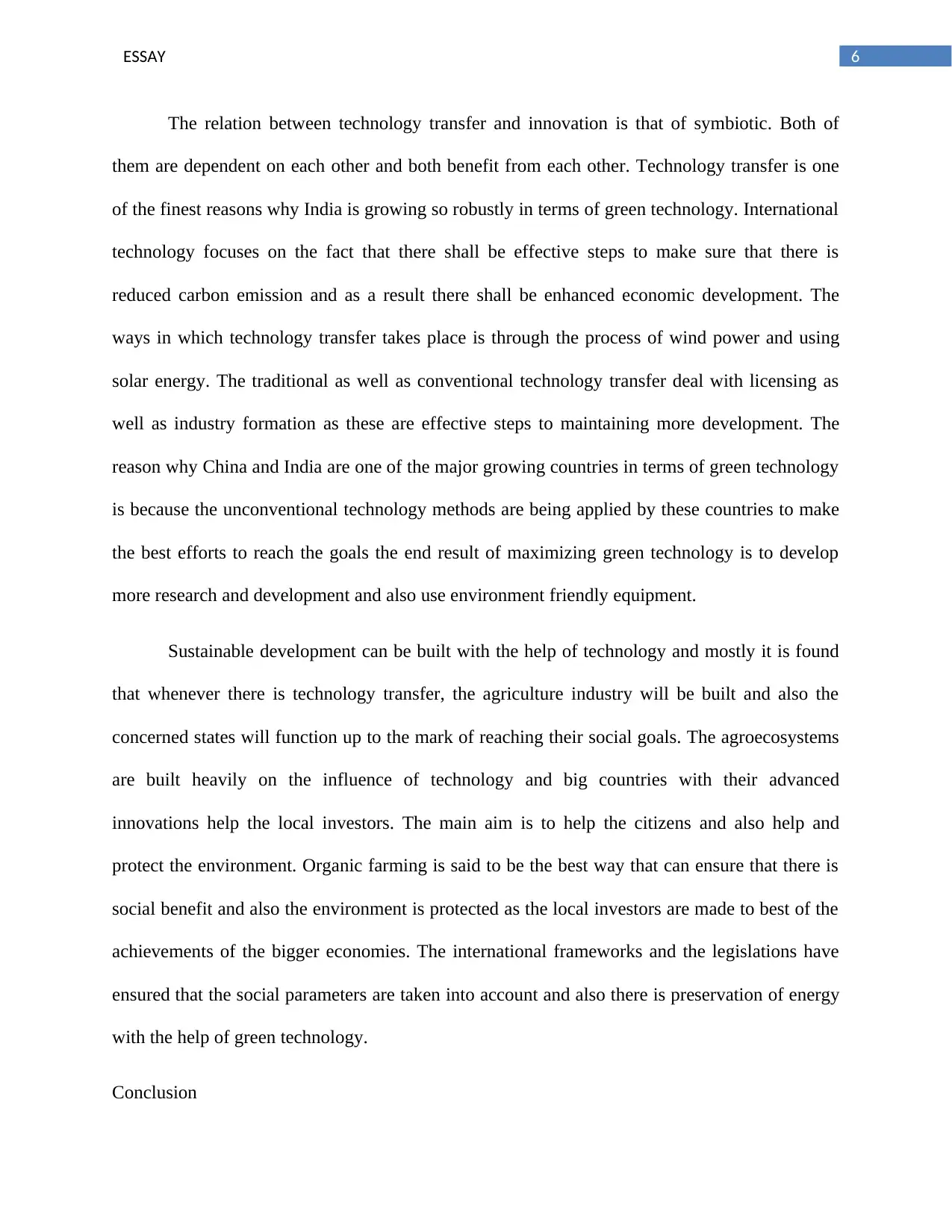
6ESSAY
The relation between technology transfer and innovation is that of symbiotic. Both of
them are dependent on each other and both benefit from each other. Technology transfer is one
of the finest reasons why India is growing so robustly in terms of green technology. International
technology focuses on the fact that there shall be effective steps to make sure that there is
reduced carbon emission and as a result there shall be enhanced economic development. The
ways in which technology transfer takes place is through the process of wind power and using
solar energy. The traditional as well as conventional technology transfer deal with licensing as
well as industry formation as these are effective steps to maintaining more development. The
reason why China and India are one of the major growing countries in terms of green technology
is because the unconventional technology methods are being applied by these countries to make
the best efforts to reach the goals the end result of maximizing green technology is to develop
more research and development and also use environment friendly equipment.
Sustainable development can be built with the help of technology and mostly it is found
that whenever there is technology transfer, the agriculture industry will be built and also the
concerned states will function up to the mark of reaching their social goals. The agroecosystems
are built heavily on the influence of technology and big countries with their advanced
innovations help the local investors. The main aim is to help the citizens and also help and
protect the environment. Organic farming is said to be the best way that can ensure that there is
social benefit and also the environment is protected as the local investors are made to best of the
achievements of the bigger economies. The international frameworks and the legislations have
ensured that the social parameters are taken into account and also there is preservation of energy
with the help of green technology.
Conclusion
The relation between technology transfer and innovation is that of symbiotic. Both of
them are dependent on each other and both benefit from each other. Technology transfer is one
of the finest reasons why India is growing so robustly in terms of green technology. International
technology focuses on the fact that there shall be effective steps to make sure that there is
reduced carbon emission and as a result there shall be enhanced economic development. The
ways in which technology transfer takes place is through the process of wind power and using
solar energy. The traditional as well as conventional technology transfer deal with licensing as
well as industry formation as these are effective steps to maintaining more development. The
reason why China and India are one of the major growing countries in terms of green technology
is because the unconventional technology methods are being applied by these countries to make
the best efforts to reach the goals the end result of maximizing green technology is to develop
more research and development and also use environment friendly equipment.
Sustainable development can be built with the help of technology and mostly it is found
that whenever there is technology transfer, the agriculture industry will be built and also the
concerned states will function up to the mark of reaching their social goals. The agroecosystems
are built heavily on the influence of technology and big countries with their advanced
innovations help the local investors. The main aim is to help the citizens and also help and
protect the environment. Organic farming is said to be the best way that can ensure that there is
social benefit and also the environment is protected as the local investors are made to best of the
achievements of the bigger economies. The international frameworks and the legislations have
ensured that the social parameters are taken into account and also there is preservation of energy
with the help of green technology.
Conclusion
Paraphrase This Document
Need a fresh take? Get an instant paraphrase of this document with our AI Paraphraser
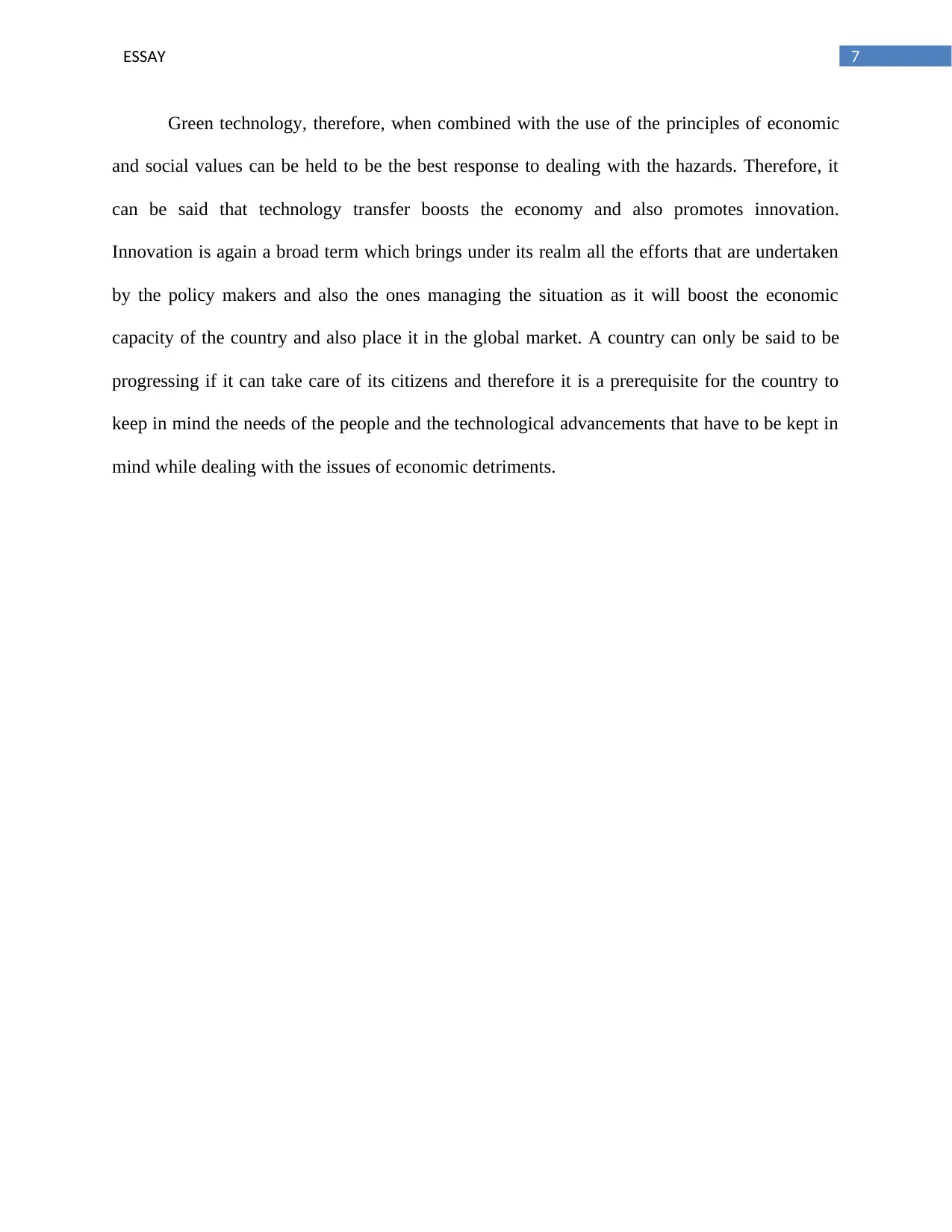
7ESSAY
Green technology, therefore, when combined with the use of the principles of economic
and social values can be held to be the best response to dealing with the hazards. Therefore, it
can be said that technology transfer boosts the economy and also promotes innovation.
Innovation is again a broad term which brings under its realm all the efforts that are undertaken
by the policy makers and also the ones managing the situation as it will boost the economic
capacity of the country and also place it in the global market. A country can only be said to be
progressing if it can take care of its citizens and therefore it is a prerequisite for the country to
keep in mind the needs of the people and the technological advancements that have to be kept in
mind while dealing with the issues of economic detriments.
Green technology, therefore, when combined with the use of the principles of economic
and social values can be held to be the best response to dealing with the hazards. Therefore, it
can be said that technology transfer boosts the economy and also promotes innovation.
Innovation is again a broad term which brings under its realm all the efforts that are undertaken
by the policy makers and also the ones managing the situation as it will boost the economic
capacity of the country and also place it in the global market. A country can only be said to be
progressing if it can take care of its citizens and therefore it is a prerequisite for the country to
keep in mind the needs of the people and the technological advancements that have to be kept in
mind while dealing with the issues of economic detriments.
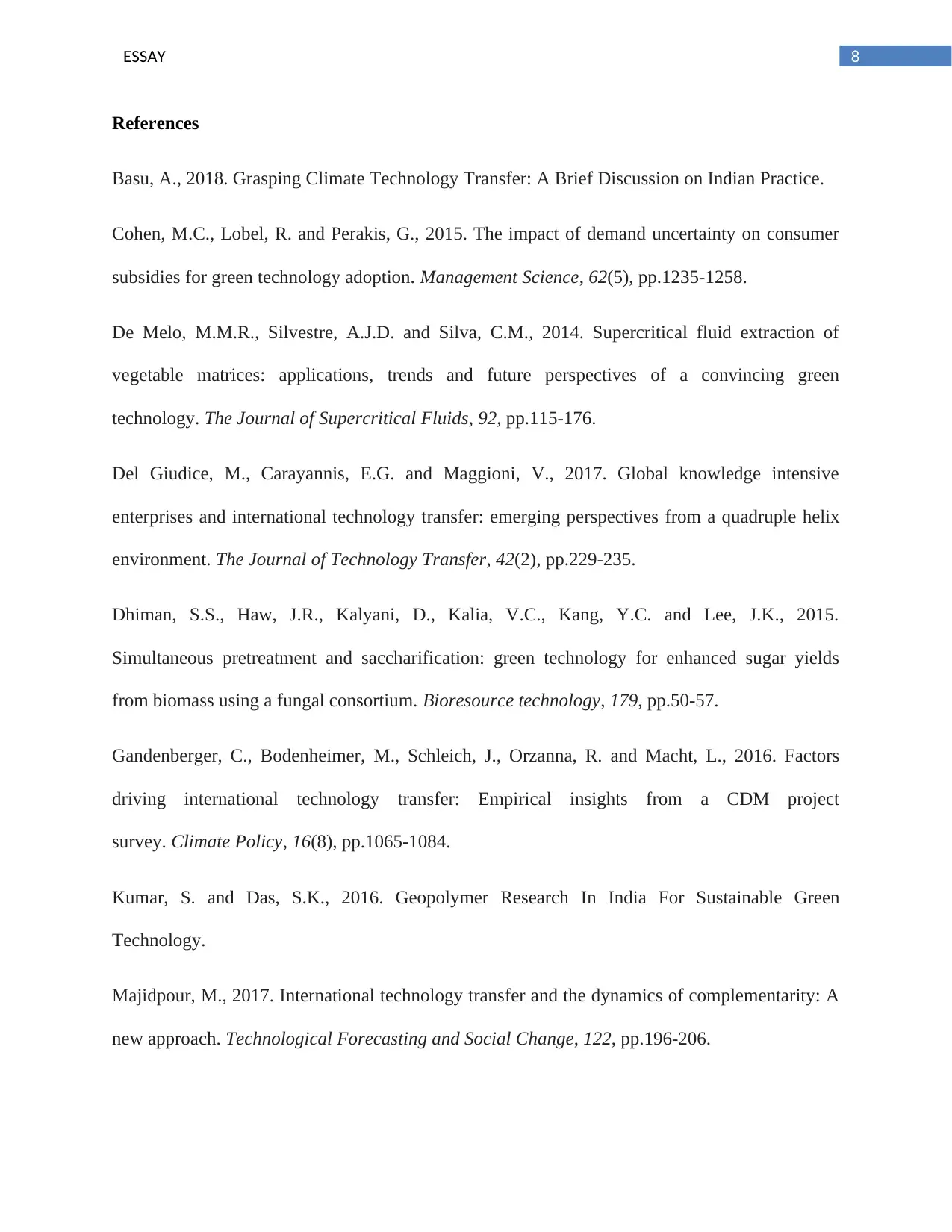
8ESSAY
References
Basu, A., 2018. Grasping Climate Technology Transfer: A Brief Discussion on Indian Practice.
Cohen, M.C., Lobel, R. and Perakis, G., 2015. The impact of demand uncertainty on consumer
subsidies for green technology adoption. Management Science, 62(5), pp.1235-1258.
De Melo, M.M.R., Silvestre, A.J.D. and Silva, C.M., 2014. Supercritical fluid extraction of
vegetable matrices: applications, trends and future perspectives of a convincing green
technology. The Journal of Supercritical Fluids, 92, pp.115-176.
Del Giudice, M., Carayannis, E.G. and Maggioni, V., 2017. Global knowledge intensive
enterprises and international technology transfer: emerging perspectives from a quadruple helix
environment. The Journal of Technology Transfer, 42(2), pp.229-235.
Dhiman, S.S., Haw, J.R., Kalyani, D., Kalia, V.C., Kang, Y.C. and Lee, J.K., 2015.
Simultaneous pretreatment and saccharification: green technology for enhanced sugar yields
from biomass using a fungal consortium. Bioresource technology, 179, pp.50-57.
Gandenberger, C., Bodenheimer, M., Schleich, J., Orzanna, R. and Macht, L., 2016. Factors
driving international technology transfer: Empirical insights from a CDM project
survey. Climate Policy, 16(8), pp.1065-1084.
Kumar, S. and Das, S.K., 2016. Geopolymer Research In India For Sustainable Green
Technology.
Majidpour, M., 2017. International technology transfer and the dynamics of complementarity: A
new approach. Technological Forecasting and Social Change, 122, pp.196-206.
References
Basu, A., 2018. Grasping Climate Technology Transfer: A Brief Discussion on Indian Practice.
Cohen, M.C., Lobel, R. and Perakis, G., 2015. The impact of demand uncertainty on consumer
subsidies for green technology adoption. Management Science, 62(5), pp.1235-1258.
De Melo, M.M.R., Silvestre, A.J.D. and Silva, C.M., 2014. Supercritical fluid extraction of
vegetable matrices: applications, trends and future perspectives of a convincing green
technology. The Journal of Supercritical Fluids, 92, pp.115-176.
Del Giudice, M., Carayannis, E.G. and Maggioni, V., 2017. Global knowledge intensive
enterprises and international technology transfer: emerging perspectives from a quadruple helix
environment. The Journal of Technology Transfer, 42(2), pp.229-235.
Dhiman, S.S., Haw, J.R., Kalyani, D., Kalia, V.C., Kang, Y.C. and Lee, J.K., 2015.
Simultaneous pretreatment and saccharification: green technology for enhanced sugar yields
from biomass using a fungal consortium. Bioresource technology, 179, pp.50-57.
Gandenberger, C., Bodenheimer, M., Schleich, J., Orzanna, R. and Macht, L., 2016. Factors
driving international technology transfer: Empirical insights from a CDM project
survey. Climate Policy, 16(8), pp.1065-1084.
Kumar, S. and Das, S.K., 2016. Geopolymer Research In India For Sustainable Green
Technology.
Majidpour, M., 2017. International technology transfer and the dynamics of complementarity: A
new approach. Technological Forecasting and Social Change, 122, pp.196-206.
⊘ This is a preview!⊘
Do you want full access?
Subscribe today to unlock all pages.

Trusted by 1+ million students worldwide
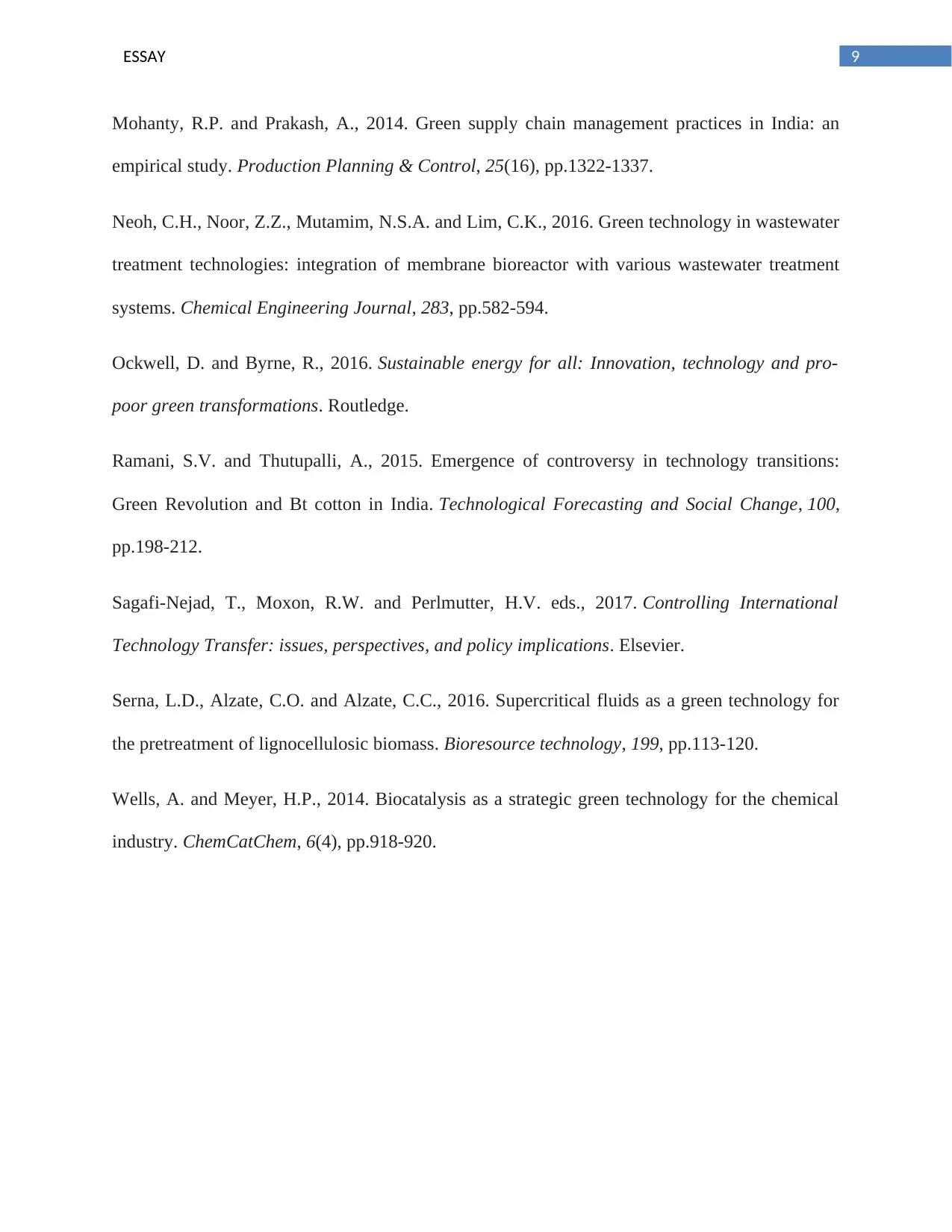
9ESSAY
Mohanty, R.P. and Prakash, A., 2014. Green supply chain management practices in India: an
empirical study. Production Planning & Control, 25(16), pp.1322-1337.
Neoh, C.H., Noor, Z.Z., Mutamim, N.S.A. and Lim, C.K., 2016. Green technology in wastewater
treatment technologies: integration of membrane bioreactor with various wastewater treatment
systems. Chemical Engineering Journal, 283, pp.582-594.
Ockwell, D. and Byrne, R., 2016. Sustainable energy for all: Innovation, technology and pro-
poor green transformations. Routledge.
Ramani, S.V. and Thutupalli, A., 2015. Emergence of controversy in technology transitions:
Green Revolution and Bt cotton in India. Technological Forecasting and Social Change, 100,
pp.198-212.
Sagafi-Nejad, T., Moxon, R.W. and Perlmutter, H.V. eds., 2017. Controlling International
Technology Transfer: issues, perspectives, and policy implications. Elsevier.
Serna, L.D., Alzate, C.O. and Alzate, C.C., 2016. Supercritical fluids as a green technology for
the pretreatment of lignocellulosic biomass. Bioresource technology, 199, pp.113-120.
Wells, A. and Meyer, H.P., 2014. Biocatalysis as a strategic green technology for the chemical
industry. ChemCatChem, 6(4), pp.918-920.
Mohanty, R.P. and Prakash, A., 2014. Green supply chain management practices in India: an
empirical study. Production Planning & Control, 25(16), pp.1322-1337.
Neoh, C.H., Noor, Z.Z., Mutamim, N.S.A. and Lim, C.K., 2016. Green technology in wastewater
treatment technologies: integration of membrane bioreactor with various wastewater treatment
systems. Chemical Engineering Journal, 283, pp.582-594.
Ockwell, D. and Byrne, R., 2016. Sustainable energy for all: Innovation, technology and pro-
poor green transformations. Routledge.
Ramani, S.V. and Thutupalli, A., 2015. Emergence of controversy in technology transitions:
Green Revolution and Bt cotton in India. Technological Forecasting and Social Change, 100,
pp.198-212.
Sagafi-Nejad, T., Moxon, R.W. and Perlmutter, H.V. eds., 2017. Controlling International
Technology Transfer: issues, perspectives, and policy implications. Elsevier.
Serna, L.D., Alzate, C.O. and Alzate, C.C., 2016. Supercritical fluids as a green technology for
the pretreatment of lignocellulosic biomass. Bioresource technology, 199, pp.113-120.
Wells, A. and Meyer, H.P., 2014. Biocatalysis as a strategic green technology for the chemical
industry. ChemCatChem, 6(4), pp.918-920.
1 out of 10
Related Documents
Your All-in-One AI-Powered Toolkit for Academic Success.
+13062052269
info@desklib.com
Available 24*7 on WhatsApp / Email
![[object Object]](/_next/static/media/star-bottom.7253800d.svg)
Unlock your academic potential
Copyright © 2020–2025 A2Z Services. All Rights Reserved. Developed and managed by ZUCOL.





